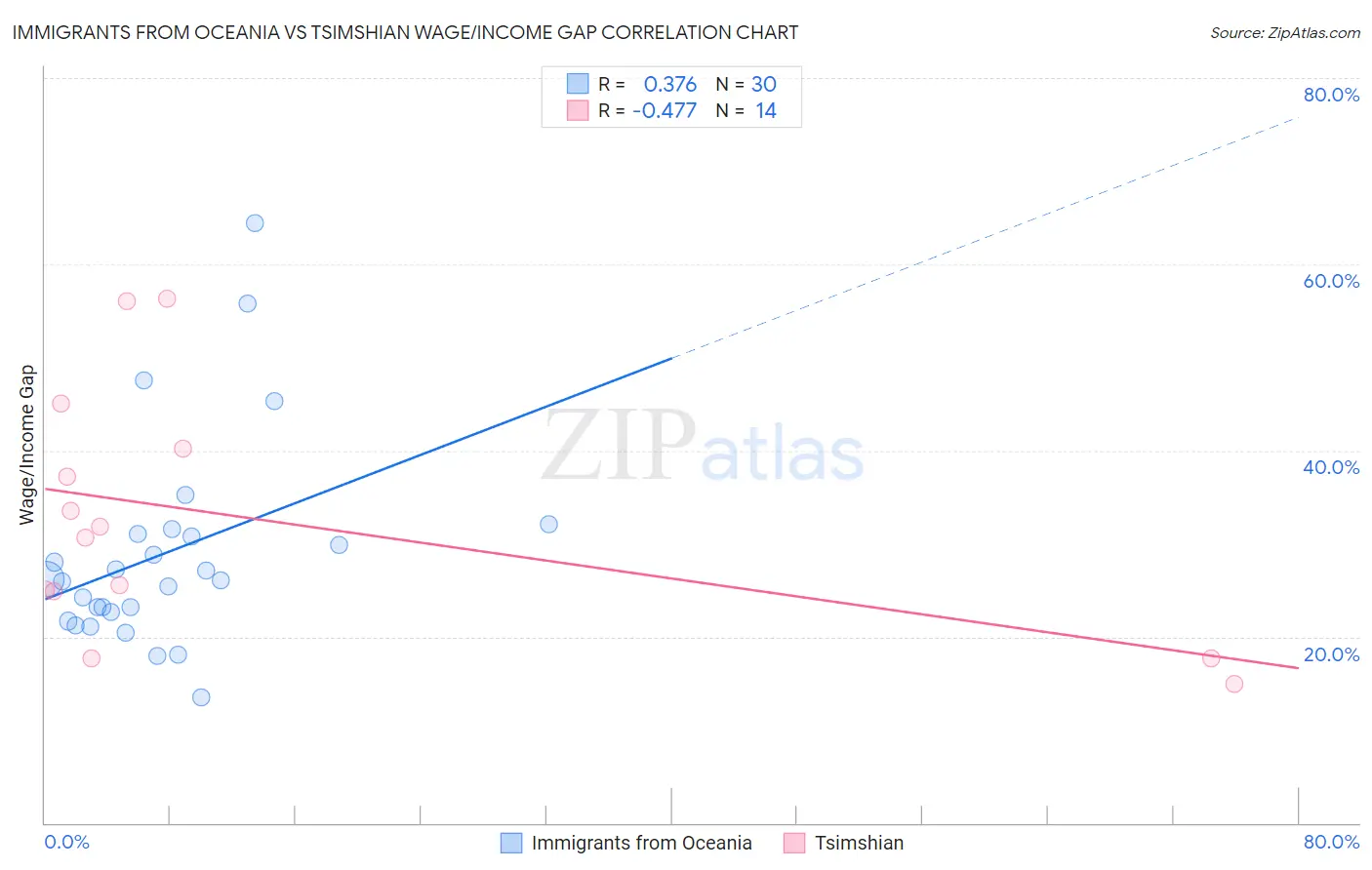Immigrants from Oceania vs Tsimshian Wage/Income Gap
COMPARE
Immigrants from Oceania
Tsimshian
Wage/Income Gap
Wage/Income Gap Comparison
Immigrants from Oceania
Tsimshian
25.6%
WAGE/INCOME GAP
57.5/ 100
METRIC RATING
170th/ 347
METRIC RANK
23.9%
WAGE/INCOME GAP
98.9/ 100
METRIC RATING
103rd/ 347
METRIC RANK
Immigrants from Oceania vs Tsimshian Wage/Income Gap Correlation Chart
The statistical analysis conducted on geographies consisting of 305,340,706 people shows a mild positive correlation between the proportion of Immigrants from Oceania and wage/income gap percentage in the United States with a correlation coefficient (R) of 0.376 and weighted average of 25.6%. Similarly, the statistical analysis conducted on geographies consisting of 15,623,634 people shows a moderate negative correlation between the proportion of Tsimshian and wage/income gap percentage in the United States with a correlation coefficient (R) of -0.477 and weighted average of 23.9%, a difference of 7.4%.

Wage/Income Gap Correlation Summary
| Measurement | Immigrants from Oceania | Tsimshian |
| Minimum | 13.4% | 14.9% |
| Maximum | 64.4% | 56.3% |
| Range | 50.9% | 41.4% |
| Mean | 29.0% | 32.6% |
| Median | 26.1% | 31.2% |
| Interquartile 25% (IQ1) | 22.7% | 24.9% |
| Interquartile 75% (IQ3) | 31.1% | 40.2% |
| Interquartile Range (IQR) | 8.4% | 15.3% |
| Standard Deviation (Sample) | 11.1% | 13.2% |
| Standard Deviation (Population) | 10.9% | 12.7% |
Similar Demographics by Wage/Income Gap
Demographics Similar to Immigrants from Oceania by Wage/Income Gap
In terms of wage/income gap, the demographic groups most similar to Immigrants from Oceania are Immigrants from Greece (25.7%, a difference of 0.060%), Peruvian (25.6%, a difference of 0.17%), Immigrants from Chile (25.7%, a difference of 0.28%), Immigrants from Belarus (25.7%, a difference of 0.31%), and Seminole (25.6%, a difference of 0.35%).
| Demographics | Rating | Rank | Wage/Income Gap |
| Native Hawaiians | 69.0 /100 | #163 | Good 25.4% |
| Koreans | 68.6 /100 | #164 | Good 25.4% |
| Immigrants | Hong Kong | 64.0 /100 | #165 | Good 25.5% |
| Immigrants | Ukraine | 63.8 /100 | #166 | Good 25.5% |
| Paiute | 62.9 /100 | #167 | Good 25.5% |
| Seminole | 62.6 /100 | #168 | Good 25.6% |
| Peruvians | 60.1 /100 | #169 | Good 25.6% |
| Immigrants | Oceania | 57.5 /100 | #170 | Average 25.6% |
| Immigrants | Greece | 56.6 /100 | #171 | Average 25.7% |
| Immigrants | Chile | 53.2 /100 | #172 | Average 25.7% |
| Immigrants | Belarus | 52.9 /100 | #173 | Average 25.7% |
| Alaskan Athabascans | 50.0 /100 | #174 | Average 25.8% |
| Sri Lankans | 47.0 /100 | #175 | Average 25.8% |
| Paraguayans | 46.7 /100 | #176 | Average 25.8% |
| Cambodians | 45.1 /100 | #177 | Average 25.8% |
Demographics Similar to Tsimshian by Wage/Income Gap
In terms of wage/income gap, the demographic groups most similar to Tsimshian are Immigrants from Laos (23.8%, a difference of 0.23%), Tlingit-Haida (24.0%, a difference of 0.33%), Japanese (23.8%, a difference of 0.37%), Moroccan (24.0%, a difference of 0.39%), and Sudanese (24.0%, a difference of 0.39%).
| Demographics | Rating | Rank | Wage/Income Gap |
| Kiowa | 99.4 /100 | #96 | Exceptional 23.6% |
| Immigrants | Sudan | 99.4 /100 | #97 | Exceptional 23.6% |
| Immigrants | Latin America | 99.2 /100 | #98 | Exceptional 23.7% |
| Aleuts | 99.2 /100 | #99 | Exceptional 23.7% |
| Yakama | 99.2 /100 | #100 | Exceptional 23.7% |
| Japanese | 99.1 /100 | #101 | Exceptional 23.8% |
| Immigrants | Laos | 99.0 /100 | #102 | Exceptional 23.8% |
| Tsimshian | 98.9 /100 | #103 | Exceptional 23.9% |
| Tlingit-Haida | 98.7 /100 | #104 | Exceptional 24.0% |
| Moroccans | 98.6 /100 | #105 | Exceptional 24.0% |
| Sudanese | 98.6 /100 | #106 | Exceptional 24.0% |
| Yaqui | 98.4 /100 | #107 | Exceptional 24.0% |
| Immigrants | Albania | 98.4 /100 | #108 | Exceptional 24.0% |
| Ugandans | 98.3 /100 | #109 | Exceptional 24.1% |
| Immigrants | Morocco | 98.1 /100 | #110 | Exceptional 24.1% |